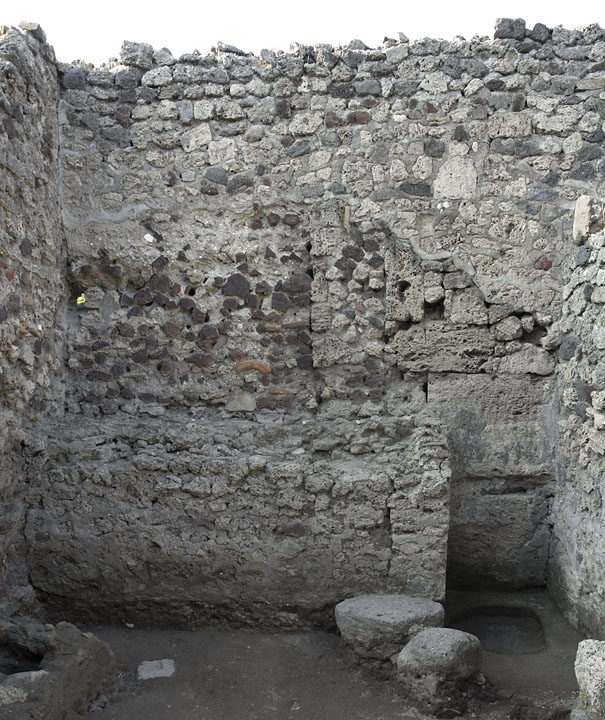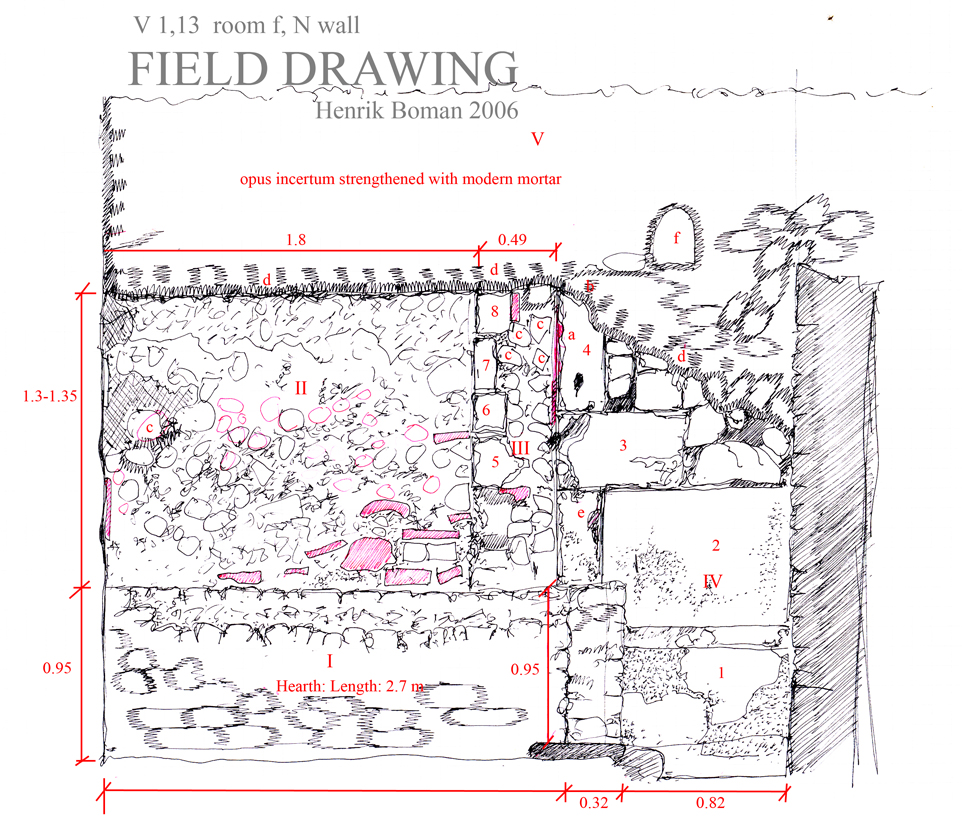North Wall
Description
Henrik Boman & Monika Nilsson
The N wall in room f is divided into five sections, based on the significant features of the wall. I) The hearth. II) The (assumed) second closing of the door. III) The first closing (narrowing) of the door. IV) The quader blocks and the upper opus incertum of the N wall. V) The upper section of the wall, assumed to be modern.
The N wall in room d is divided into five sections, based on the significant features of the wall.
I. The hearth
II. The (assumed) second closing of the door
III. The first closing (narrowing) of the door.
IV. The quader blocks and the upper opus incertum of the N wall
V. The upper section of the wall, assumed to be modern.
Measurements:
H W D
Hearth 0.95 m 2.7 m (including the extension) 0.73 m
Extension of hearth 0.32 m
Closed door I 0.49 m
Closed door II 2.25 — 2.3 m 1.8 m
Hearth — E wall 0.82 m
Measurements of the blocks (+ = more than the measurement given)
h b
1 +0.7 m
2 0.82 m +0.9 m
3 0.32 m 0.75 m
4 0.49 m 0.25 m
Description of the blocks:
1. Large quader block, end not visible, large amount of plaster, could be damaged.
2. Large quader block, continues behind the E wall
3. Small quader block, damaged. Presumably originally a large block.
4. Ortostate, upper part damaged. Plaster on the inside, which extends over several stone, ie cannot be a spoil.
5. Small block, as with 5- 8 constructs the door frame to the close door.
6-8 Small block, cut, more or less rectangular.
I. Hearth
L: 2.7 m
H 0.95 m (from the basalt stones)
D. 0.73 m
Masoned hearth, with a E side which seems to be modern (0.49 m), since the unremoved lapille over the well in the NE corner extends in under the hearth. This assumed modern part is in line with one of the basalt stones. The core is built of mortar, reused material, and stones, limestone domination, with few cruma. Large amount of modern mortar in the front. The hearth is presumably heavily restored. The top paving is not preserved, though the W part of the hearth is fairly even and could on good grounds be assumed to correspond to the original height of the hearth (as restored). The hearth do not bound to the walls it abuts.
II. Closed door, main section (2nd closing)
As seen on the N facade, this part of the wall is almost exclusively built in cruma of varying sizes. Some terracotta fragments are used. Light coloured mortar with large white lime intrusions. Parts of the surface stones has fallen out. Modern mortar also found below this area (c). The upper part of the wall seems reconstructed. A clear line (d) seem which ought to correspond to the preserved wall and the reconstructed wall, as we also seen in the N facade.
III. Closed door, 1st closing (narrowing)
Plaster is found on the inside of the block in area IV, which indicates that this is a closed door. The plaster (a) extends over several blocks, and together with the appearance of the structure of the wall, and the location of the block may lead us to the conclusion that this block is not a spoil. This section has a structure of smaller stones, cruma and brick/tile with fairly large amounts of mortar towards the closed door original doorframe (IV), and larger stone to the assumed new door frame, facing the wall in the closed door (II) in the later stage.In room f there seems not to be any plaster in the door opening towards section II. This is not conclusive, though it might reduce the phases of the closing of the door to one single phase, not two as assumed in this description. The upper part of the original door is not preserved and we cannot estimate the original height of the door, it most likely exceeded 2.2 m, the today preserved height of the door.
IV. Quader blocks of the N facade
Two large blocks, with cuttings in the upper block, as the top of a niche, of which nothing is visible in the lower block. The cutting is partly filled in, with cruma, lava and cement (Kolla). The cutting is c. 0.15 m high and c. 0.08 m deep. Above the large quader blocks (1-2), is a smaller block (3) is a ortostates (4). The ortostate is damaged at the top, in line with the border visible between the ancient and the area above, which on grounds could be assumed to be a modern restoration. Small blocks are found in this part of the wall, mixed with smaller stones and plaster spoils. A part of the wall is missing (e), which could be a missing or heavily eroded block. Large amounts of mortar found in this area. In several areas has the mortar eroded and the stones are left exposed, and in some places has the surface stones fallen out.
Plaster: Plaster (UP) found on the quader blocks, however few remains other stones. No larger areas extending over several stones are found .
V. Upper part of the wall
The wall above the visible line (d) area characterised by modern concrete. The technique is opus incertum, with one larger block (f). Lime stone is dominating, though lava and cruma are quit extensively used. This area extends over the line of the E wall, which do not bound to the N wall.


